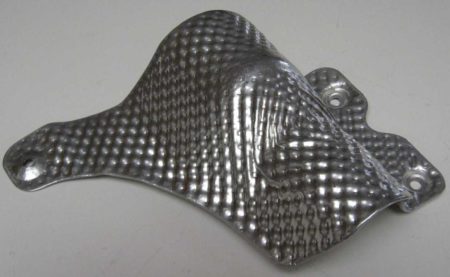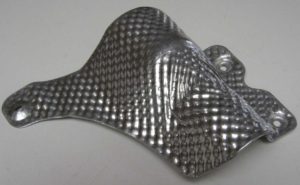 Heat has always been an issue in and around engines. Over the last few years, heat has increased significantly in these areas such that engineering teams need to include provisions for thermal management in their designs.
Heat has always been an issue in and around engines. Over the last few years, heat has increased significantly in these areas such that engineering teams need to include provisions for thermal management in their designs.
In comparison to many other technologies, heat shields are a relatively new concept. They have begun to be used regularly over the last few years, but are still new enough to not yet be the norm for everyone. If you’re still learning more about this technology, we invite you to continue reading.
Here at Metal Tech Industries, we are proponents of embossed heat shield materials. They are lightweight, easy to manufacture and provide 4x the stiffness compared to flat sheets. All of the information below is based on using embossed sheets.
Why Heat Shielding?
1. It can be done relatively inexpensively.
When you hear the term “heat shield”, you may envision a large expensive piece added to your design. While there is a need for shielding such as this, there are also other ways to protect sensitive components from heat. First, does a gasket stand between the heat source and your sensitive components? If so, you may elect to use a gasket with insulative properties that will reduce the heat conduction. Second, you can hand-form your own heat shields. With the right materials, you can effectively reduce the heat flow. If the gaskets don’t offer enough protection or the volume is too large to manually form shields, you’ll need to look at shields formed by automation.
2. You can see a significant temperature reduction.
It doesn’t take much to see a significant drop in temperature. Using only one layer of embossed aluminum as a heat shield results in a 66% reduction in temperature. If you increase that to two layers, it can jump to an 83% reduction in temperature. That’s some serious protection!
3. They aren’t one-size-fits-all.
The type shield you select can be customized to your specific needs. Standard options range from one layer to three-layer designs. Adding layers adds additional temperature and noise reduction. Once you know your source temps and design parameters, you can find the shield design that works best for you.
4. Shielding can be very lightweight.
If you are concerned about the weight that a shield will add to your application, embossed is the way you want to go. You can achieve the same stiffness by using a 0.5mm embossed sheet vs a 2mm blank (flat) sheet.
Making the Decision
If heat is a concern in your application, there are various ways to successfully achieve the level of thermal management required. If you aren’t sure where to start, talk with your trusted heat shield supplier to talk through your applications and your options. It may be as simple as changing a gasket, but you also may need to engineer a solution to fit into your application.
How often is thermal management a concern to you? If you are interested in subscribing to Sealed-In’s blog posts, email sales@mtigasket.com.

Heat has always been an issue in and around engines. Over the last few years, heat has increased significantly in these areas such that engineering teams need to include provisions for thermal management in their designs.
In comparison to many other technologies, heat shields are a relatively new concept. They have begun to be used regularly over the last few years, but are still new enough to not yet be the norm for everyone. If you’re still learning more about this technology, we invite you to continue reading.
Here at Metal Tech Industries, we are proponents of embossed heat shield materials. They are lightweight, easy to manufacture and provide 4x the stiffness compared to flat sheets. All of the information below is based on using embossed sheets.
Why Heat Shielding?
1. It can be done relatively inexpensively.
When you hear the term “heat shield”, you may envision a large expensive piece added to your design. While there is a need for shielding such as this, there are also other ways to protect sensitive components from heat. First, does a gasket stand between the heat source and your sensitive components? If so, you may elect to use a gasket with insulative properties that will reduce the heat conduction. Second, you can hand-form your own heat shields. With the right materials, you can effectively reduce the heat flow. If the gaskets don’t offer enough protection or the volume is too large to manually form shields, you’ll need to look at shields formed by automation.
2. You can see a significant temperature reduction.
It doesn’t take much to see a significant drop in temperature. Using only one layer of embossed aluminum as a heat shield results in a 66% reduction in temperature. If you increase that to two layers, it can jump to an 83% reduction in temperature. That’s some serious protection!
3. They aren’t one-size-fits-all.
The type shield you select can be customized to your specific needs. Standard options range from one layer to three-layer designs. Adding layers adds additional temperature and noise reduction. Once you know your source temps and design parameters, you can find the shield design that works best for you.
4. Shielding can be very lightweight.
If you are concerned about the weight that a shield will add to your application, embossed is the way you want to go. You can achieve the same stiffness by using a 0.5mm embossed sheet vs a 2mm blank (flat) sheet.
Making the Decision
If heat is a concern in your application, there are various ways to successfully achieve the level of thermal management required. If you aren’t sure where to start, talk with your trusted heat shield supplier to talk through your applications and your options. It may be as simple as changing a gasket, but you also may need to engineer a solution to fit into your application.
How often is thermal management a concern to you? If you are interested in subscribing to Sealed-In’s blog posts, email sales@mtigasket.com.

Heat has always been an issue in and around engines. Over the last few years, heat has increased significantly in these areas such that engineering teams need to include provisions for thermal management in their designs.
In comparison to many other technologies, heat shields are a relatively new concept. They have begun to be used regularly over the last few years, but are still new enough to not yet be the norm for everyone. If you’re still learning more about this technology, we invite you to continue reading.
Here at Metal Tech Industries, we are proponents of embossed heat shield materials. They are lightweight, easy to manufacture and provide 4x the stiffness compared to flat sheets. All of the information below is based on using embossed sheets.
Why Heat Shielding?
1. It can be done relatively inexpensively.
When you hear the term “heat shield”, you may envision a large expensive piece added to your design. While there is a need for shielding such as this, there are also other ways to protect sensitive components from heat. First, does a gasket stand between the heat source and your sensitive components? If so, you may elect to use a gasket with insulative properties that will reduce the heat conduction. Second, you can hand-form your own heat shields. With the right materials, you can effectively reduce the heat flow. If the gaskets don’t offer enough protection or the volume is too large to manually form shields, you’ll need to look at shields formed by automation.
2. You can see a significant temperature reduction.
It doesn’t take much to see a significant drop in temperature. Using only one layer of embossed aluminum as a heat shield results in a 66% reduction in temperature. If you increase that to two layers, it can jump to an 83% reduction in temperature. That’s some serious protection!
3. They aren’t one-size-fits-all.
The type shield you select can be customized to your specific needs. Standard options range from one layer to three-layer designs. Adding layers adds additional temperature and noise reduction. Once you know your source temps and design parameters, you can find the shield design that works best for you.
4. Shielding can be very lightweight.
If you are concerned about the weight that a shield will add to your application, embossed is the way you want to go. You can achieve the same stiffness by using a 0.5mm embossed sheet vs a 2mm blank (flat) sheet.
Making the Decision
If heat is a concern in your application, there are various ways to successfully achieve the level of thermal management required. If you aren’t sure where to start, talk with your trusted heat shield supplier to talk through your applications and your options. It may be as simple as changing a gasket, but you also may need to engineer a solution to fit into your application.
How often is thermal management a concern to you? If you are interested in subscribing to Sealed-In’s blog posts, email sales@mtigasket.com.
